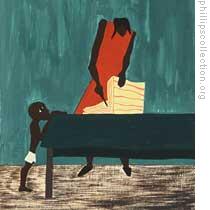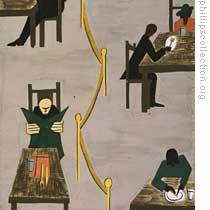-
(单词翻译:双击或拖选)
These 60 paintings tell about the movement of African-Americans in the first half of the 20th century. Transcript1 of radio broadcast:
06 July 2008
VOICE ONE:
Welcome to THIS IS AMERICA in VOA Special English. I'm Steve Ember.
VOICE TWO:
And I'm Barbara Klein. This week we tell about an important series of historical paintings created by the African-American artist Jacob Lawrence. This modernist painter was only twenty-four when his Migration2 Series made him nationally famous. All sixty paintings in this series are currently being shown at the Phillips Collection in Washington, D.C. These skillful works are as expressive3 and meaningful today as they were when Jacob Lawrence first painted them over sixty years ago.
(MUSIC)
VOICE ONE:
 |
| Detail from Panel No. 1: “During World War I there was a great migration north by southern African Americans.” |
The Migration Series by Jacob Lawrence is as much a history lesson as it is a shining example of artistic4 skill. Starting around nineteen ten, thousands of African-Americans living in the rural southern part of the United States began to move, or migrate, to northern industrial cities. Many African-Americans left their homes in the South to escape discrimination, a worsening economy, and agricultural problems. The beginning of World War One in nineteen fourteen created an even larger demand for workers in the factories of the North.
VOICE TWO:
It is estimated that over a million African-Americans moved north during this period to seek better jobs. They moved to cities like New York; Pittsburgh, Pennsylvania; Chicago, Illinois and Detroit, Michigan. This movement of people had a big effect on the economy and communities of the South.
Jacob Lawrence had a personal connection with the Great Migration. Before he was born, his own parents moved from the South to Atlantic City, New Jersey5, then later to Philadelphia, Pennsylvania.
VOICE ONE:
Elsa Smithgall is the associate curator at the Phillips who organized this show on Jacob Lawrence. Here, she talks about the importance of his Migration Series.
ELSA SMITHGALL: "It really taps such universal themes that we still can really relate to. We think about themes of struggle, and perseverance6 and resilience, and these qualities that really are still at the heart of the immigrant experience in this country today. We have over two hundred million migrants estimated in the world today. One of the things about the series is that it transcends7 its own time. It is important historically, but at the same time it very much informs our present and our thinking about the future."
VOICE TWO:
In nineteen thirty, when Jacob was thirteen, his mother moved him and his brother and sister to the Harlem area of New York City. During the nineteen thirties Lawrence began taking art classes with the artist Charles Alston. First he took classes at the Utopia Children's House, then later at the Harlem Art Workshop. The Workshop was supported by the Works Progress Administration, or W.P.A. This federal government agency employed people to work on public buildings and other projects.
(MUSIC)
VOICE ONE:
In nineteen thirty-eight Jacob Lawrence began working for the W.P.A. He created several series of historical paintings that show important people and events in African-American history. These include "The Life of Frederick Douglass" and "The Life of Harriet Tubman."
VOICE TWO:
In nineteen forty, Jacob Lawrence received a grant from the Julius Rosenwald Fund. His proposed project was to paint sixty panels called "The Migration of the Negro."
With the fifteen hundred dollar grant, Lawrence found a studio that was big enough for him to be able to lay out the sixty works at the same time. He did a great deal of research at the Schomburg Collection in Harlem to better understand the experiences of people who lived during the migration.
VOICE ONE:
Lawrence used a special method to work on this series. First, he wrote out the text that would describe the sixty paintings. Then, he prepared drawings. When it was time to paint, he worked on all the panels at the same time. For example, he would apply the brown and black colors to all sixty panels before continuing on to the next color. He did this so that all of the paintings would have a visual unity8. Jacob Lawrence updated the title of this series and its captions10 in nineteen ninety-two.
VOICE TWO:
Each painting in the Migration Series measures about thirty by forty-five centimeters. Lawrence worked with tempera paints or poster paints on a hardboard material. He chose these paints because they were low in cost. And Lawrence applied11 these pure colors directly onto the work surface to achieve a bold and energetic effect.
VOICE ONE:
The Migration Series starts with a panel showing a large crowd of African-Americans in line at a bus or train station. The people in the crowd wear different colored hats and clothing. They are waiting in line under signs that show the name of the city where they are going. The words under this panel read: "During World War One there was a great migration North by Southern African-Americans."
Jacob Lawrence's style is very bold and direct. His figures are not exact or detailed12. Instead, they are stylized to suggest emotion and movement. He told a complex story using simple but expressive forms.
VOICE TWO:
The Migration Series continues with panels that show the living conditions of African-Americans in the South. You learn about the insects and flooding which severely13 damaged cotton crops. You learn about the increased price of food during the war, which made life even more difficult for poor southern farmers.
VOICE ONE:
Elsa Smithgall describes for us one panel she finds especially expressive.
ELSA SMITHGALL: "The panel we're looking at is number eleven. The caption9 reads 'The War had doubled the cost of food, making life even harder for the poor.' And, this panel is to suggest the impact that poverty played in stimulating14 the migration."
 |
| Detail from Panel No. 11: “Food had doubled in price because of the war.” |
In the painting, a woman stands at a table cutting a piece of meat while a thin little boy watches her actions with big eyes. Miz Smithgall explained the meaning of the kind of meat Jacob Lawrence chose to represent. It is fatback, one of the least costly15 cuts of pork meat. The two stand together in a room empty except for a table and candlelight hanging on the wall. The scene is very simple, but very emotionally expressive.
ELSA SMITHGALL: "He enlivens the entire scene with the color and the choice of color. And you notice there is a green wall and the woman is wearing this lovely red dress. So that there is a sense of creating some beauty within an otherwise very devastating16 kind of situation of life."
VOICE TWO:
The series continues with repeated images of migrants moving on trains towards the big northern cities. You see scenes of the factories where the migrants found work. And the southern communities they left behind. Panel thirty-three reads: "Letters from relatives in the North told of the better life there."
It shows a woman and her child in a big green bed. The woman is reading a letter. The scene is painted from a striking angle. It is as though the viewer was looking at the woman from the headboard of her bed.
VOICE ONE:
 |
| Detail from Panel No. 49: “They found discrimination in the North. It was a different kind.” |
The series also shows examples of discrimination the migrants faced both in their lives in the South and in their new lives in the North.
In panel forty-nine, you see an eating area in which black people are separated from white people by a yellow barrier. Panel fifty-nine describes that in the North, African-Americans had the freedom to vote. You can see a group waiting in line at a voting center.
(MUSIC)
VOICE TWO:
The Migration Series immediately received great attention from the art world. After completing the works in nineteen forty-one, Jacob Lawrence traveled to New Orleans, Louisiana, with his new wife, artist Gwendolyn Knight17. This was their first visit to the South.
It was there that they learned that twenty-six of Lawrence's paintings from the series were published in Fortune magazine. Later, there was an exhibit of the entire series at the Downtown Gallery in New York City. Jacob Lawrence became the first African-American to be represented by a major New York City commercial art gallery.
VOICE ONE:
Soon, the arts supporter Adele Rosenwald Levy18 bought the even numbered panels for one thousand dollars. She gave the works to the Museum of Modern Art in New York City. The Phillips Collection bought the odd number panels for the same amount of money. Because Lawrence repeated subjects in the series, it still tells a clear story with only thirty of the panels.
VOICE TWO:
Since two museums each own half of the series, it is a rare and special event to see the entire series exhibited in one place. Later in his life, Jacob Lawrence said he did not create the Migration Series to make a political statement. He said it was just a part of his life and a part of the lives of his friends and family.
Jacob Lawrence said that he hoped the series would show what human beings can experience and survive. His Migration Series tells an important part of American history using the artistic skill of one of America's great painters.
(MUSIC)
VOICE ONE:
Our program was written and produced by Dana Demange. I'm Steve Ember.
VOICE TWO:
And I'm Barbara Klein. You can see some of the paintings of the Migration Series at voaspecialenglish.com. Join us again next week for THIS IS AMERICA in VOA Special English.
 收听单词发音
收听单词发音
1
transcript

|
|
| n.抄本,誊本,副本,肄业证书 | |
参考例句: |
|
|
|
2
migration

|
|
| n.迁移,移居,(鸟类等的)迁徙 | |
参考例句: |
|
|
|
3
expressive

|
|
| adj.表现的,表达…的,富于表情的 | |
参考例句: |
|
|
|
4
artistic

|
|
| adj.艺术(家)的,美术(家)的;善于艺术创作的 | |
参考例句: |
|
|
|
5
jersey

|
|
| n.运动衫 | |
参考例句: |
|
|
|
6
perseverance

|
|
| n.坚持不懈,不屈不挠 | |
参考例句: |
|
|
|
7
transcends

|
|
| 超出或超越(经验、信念、描写能力等)的范围( transcend的第三人称单数 ); 优于或胜过… | |
参考例句: |
|
|
|
8
unity

|
|
| n.团结,联合,统一;和睦,协调 | |
参考例句: |
|
|
|
9
caption

|
|
| n.说明,字幕,标题;v.加上标题,加上说明 | |
参考例句: |
|
|
|
10
captions

|
|
| n.标题,说明文字,字幕( caption的名词复数 )v.给(图片、照片等)加说明文字( caption的第三人称单数 ) | |
参考例句: |
|
|
|
11
applied

|
|
| adj.应用的;v.应用,适用 | |
参考例句: |
|
|
|
12
detailed

|
|
| adj.详细的,详尽的,极注意细节的,完全的 | |
参考例句: |
|
|
|
13
severely

|
|
| adv.严格地;严厉地;非常恶劣地 | |
参考例句: |
|
|
|
14
stimulating

|
|
| adj.有启发性的,能激发人思考的 | |
参考例句: |
|
|
|
15
costly

|
|
| adj.昂贵的,价值高的,豪华的 | |
参考例句: |
|
|
|
16
devastating

|
|
| adj.毁灭性的,令人震惊的,强有力的 | |
参考例句: |
|
|
|
17
knight

|
|
| n.骑士,武士;爵士 | |
参考例句: |
|
|
|
18
levy

|
|
| n.征收税或其他款项,征收额 | |
参考例句: |
|
|
|















